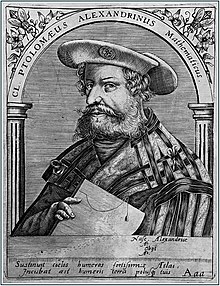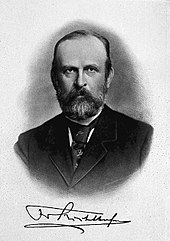Chorography
Chorography(fromχῶροςkhōros,"place" andγράφεινgraphein,"to write" ) is the art of describing or mapping a region or district,[1]and by extension such a description or map.[2]This term derives from the writings of the ancient geographerPomponius MelaandPtolemy,where it meant the geographical description of regions. However, its resonances of meaning have varied at different times. Richard Helgerson states that "chorography defines itself by opposition tochronicle.It is the genre devoted to place, and chronicle is the genre devoted to time ".[3]Darrell Rohl prefers a broad definition of "the representation of space or place".[4]

Ptolemy's definition[edit]
In his text of theGeographia(2nd century CE), Ptolemy definedgeographyas the study of the entire world, but chorography as the study of its smaller parts—provinces, regions, cities, or ports. Its goal was "an impression of a part, as when one makes an image of just an ear or an eye"; and it dealt with "the qualities rather than the quantities of the things that it sets down". Ptolemy implied that it was agraphictechnique, comprising the making of views (not simply maps), since he claimed that it required the skills of a draftsman or landscape artist, rather than the more technical skills of recording "proportional placements". Ptolemy's most recent English translators, however, render the term as "regional cartography".[5]
Renaissance revival[edit]
Ptolemy's text was rediscovered in the west at the beginning of the fifteenth century, and the term "chorography" was revived byhumanistscholars.[6]John Deein 1570 regarded the practice as "an underling, and a twig ofGeographie",by which the" plat "[plan or drawing] of a particular place would be exhibited to the eye.[7]

The term also came to be used, however, forwrittendescriptions of regions. These regions were extensively visited by the writer, who then combined local topographical description, summaries of the historical sources, and local knowledge and stories, into a text. The most influential example (at least in Britain) was probablyWilliam Camden'sBritannia(first edition 1586), which described itself on its title page as aChorographica descriptio.William Harrisonin 1587 similarly described his own "Description of Britaine" as an exercise in chorography, distinguishing it from the historical/chronological text of Holinshed'sChronicles(to which the "Description" formed an introductory section).[8]Peter Heylinin 1652 defined chorography as "the exact description of some Kingdom, Countrey, or particular Province of the same", and gave as examplesPausanias'sDescription of Greece(2nd century AD); Camden'sBritannia(1586);Lodovico Guicciardini'sDescrittione di tutti i Paesi Bassi(1567) (on theLow Countries); andLeandro Alberti'sDescrizione d'Italia(1550).[9]
Camden'sBritanniawas predominantly concerned with the history and antiquities of Britain, and, probably as a result, the term chorography in English came to be particularly associated withantiquariantexts.William Lambarde,John Stow,John Hooker,Michael Drayton,Tristram Risdon,John Aubreyand many others used it in this way, arising from a gentlemanlytopophiliaand a sense of service to one's county or city, until it was eventually often applied to the genre ofcounty history.A late example was William Grey'sChorographia(1649), a survey of the antiquities of the city ofNewcastle upon Tyne.Even before Camden's work appeared,Andrew Melvillein 1574 had referred to chorography andchronologyas the "twa lights" [two lights] ofhistory.[10]

However, the term also continued to be used for maps and map-making, particularly of sub-national orcountyareas. William Camden praised the county mapmakersChristopher SaxtonandJohn Nordenas "most skilfull (sic) Chorographers";[11]andRobert Plotin 1677[12]andChristopher Packein 1743[13]both referred to their county maps as chorographies.
By the beginning of the eighteenth century the term had largely fallen out of use in all these contexts, being superseded for most purposes by either "topography"or"cartography".Samuel Johnsonin hisDictionary(1755) made a distinction between geography, chorography and topography, arguing that geography dealt with large areas, topography with small areas, but chorography with intermediary areas, being "less in its object than geography, and greater than topography".[14]In practice, however, the term is only rarely found in English by this date.

Modern usages[edit]
In more technical geographical literature, the term had been abandoned as city views andcity mapsbecame more and more sophisticated and demanded a set of skills that required not only skilled draftsmanship but also some knowledge of scientificsurveying.However, its use was revived for a second time in the late nineteenth century by the geographerFerdinand von Richthofen.He regarded chorography as a specialization within geography, comprising the description through field observation of the particular traits of a given area.[15]
The term is also now widely used by historians and literary scholars to refer to theearly moderngenre of topographical and antiquarian literature.[16]
See also[edit]
- Local history
- Antiquarianism
- Cartography
- Khôra
- Chorology
- English county histories
- Regional geography
References[edit]
- ^Chisholm, Hugh,ed. (1911)..Encyclopædia Britannica.Vol. 6 (11th ed.). Cambridge University Press. p. 270.
- ^Merriam-Webster
- ^Helgerson 1992, p. 132.
- ^Rohl 2011, p. 1.
- ^J. L. Berggren and Alexander Jones (eds),Ptolemy's Geography(Princeton, 2000), pp. 57–59.
- ^SeeNuti, Lucia (1999). "Mapping Places: chorography and vision in the Renaissance". In Cosgrove, Denis (ed.).Mappings.London. pp. 90–108.
{{cite book}}:CS1 maint: location missing publisher (link) - ^John Dee, 'Mathematicall Praeface', in Euclid,The Elements of Geometrie,trans. H. Billingsley (London, 1570), sig. A4r.
- ^Harrison, William(1587). "An Historicall Description of the Iland of Britaine". InHolinshed, Raphael(ed.).The First and Second Volumes of Chronicles(2nd ed.). London. p. sig. [A2]v.
- ^Heylyn, Peter(1652).Cosmographie.London. p. 27.
- ^Kinloch, G. R.,ed. (1829).The Diary of Mr James Melvill, 1556–1601.Edinburgh: Bannatyne Club. pp. 38–9.
- ^Camden, William (1610). "The Author to the Reader".Britain, or a Chorographicall Description of the most flourishing Kingdomes, England, Scotland, and Ireland, and the Ilands adjoyning, out of the depth of Antiquitie.Translated byHolland, Philemon.London. p. sig. [*5]v.
- ^Plot, Robert(1677).The Natural History of Oxford-shire.Oxford. p.299.
- ^Packe, Christopher(1743).A New Philosophico-Chorographical Chart of East-Kent.[Canterbury].
- ^Johnson, Samuel(1755). "chorography".A Dictionary of the English Language.London. p. 373. Archived fromthe originalon 2018-11-19.Retrieved2018-11-18..
- ^GEO 466/566: The Profession of GeographyArchived2012-02-11 at theWayback Machine.
- ^Particularly influential in reviving the term has been Helgerson 1992, esp. pp. 105–47.
Bibliography[edit]
- Brayshay, Mark, ed. (1996).Topographical Writers in South-West England.Exeter: University of Exeter Press.ISBN0-85989-424-X.
- Broadway, Jan (2006)."No Historie So Meete": gentry culture and the development of local history in Elizabethan and early Stuart England.Manchester: Manchester University Press.ISBN978-0-7190-7294-9.
- Currie, C. R. J.; Lewis, C. P., eds. (1994).English County Histories: a guide.Stroud: Alan Sutton.ISBN0-7509-0289-2.
- Helgerson, Richard (1992).Forms of Nationhood: the Elizabethan Writing of England.Chicago: University of Chicago Press.ISBN0-226-32633-0.
- Mendyk, S. A. E. (1989)."Speculum Britanniae": regional study, antiquarianism and science in Britain to 1700.Toronto: University of Toronto Press.ISBN0-8020-5744-6.
- Rohl, Darrell J. (2011)."The Chorographic Tradition and Seventeenth- and Eighteenth-Century Scottish Antiquaries"(PDF).Journal of Art Historiography.5.
- Shanks, Michael; Witmore, Christopher (2010). "Echoes across the Past: chorography and topography in antiquarian engagements with place".Performance Research.15(4): 97–106.doi:10.1080/13528165.2010.539888.S2CID190848019.
- Witmore, Christopher (2020).Old Lands: A Chorography of the Eastern Peloponnese.London: Routledge.ISBN978-0-815-36344-6.
